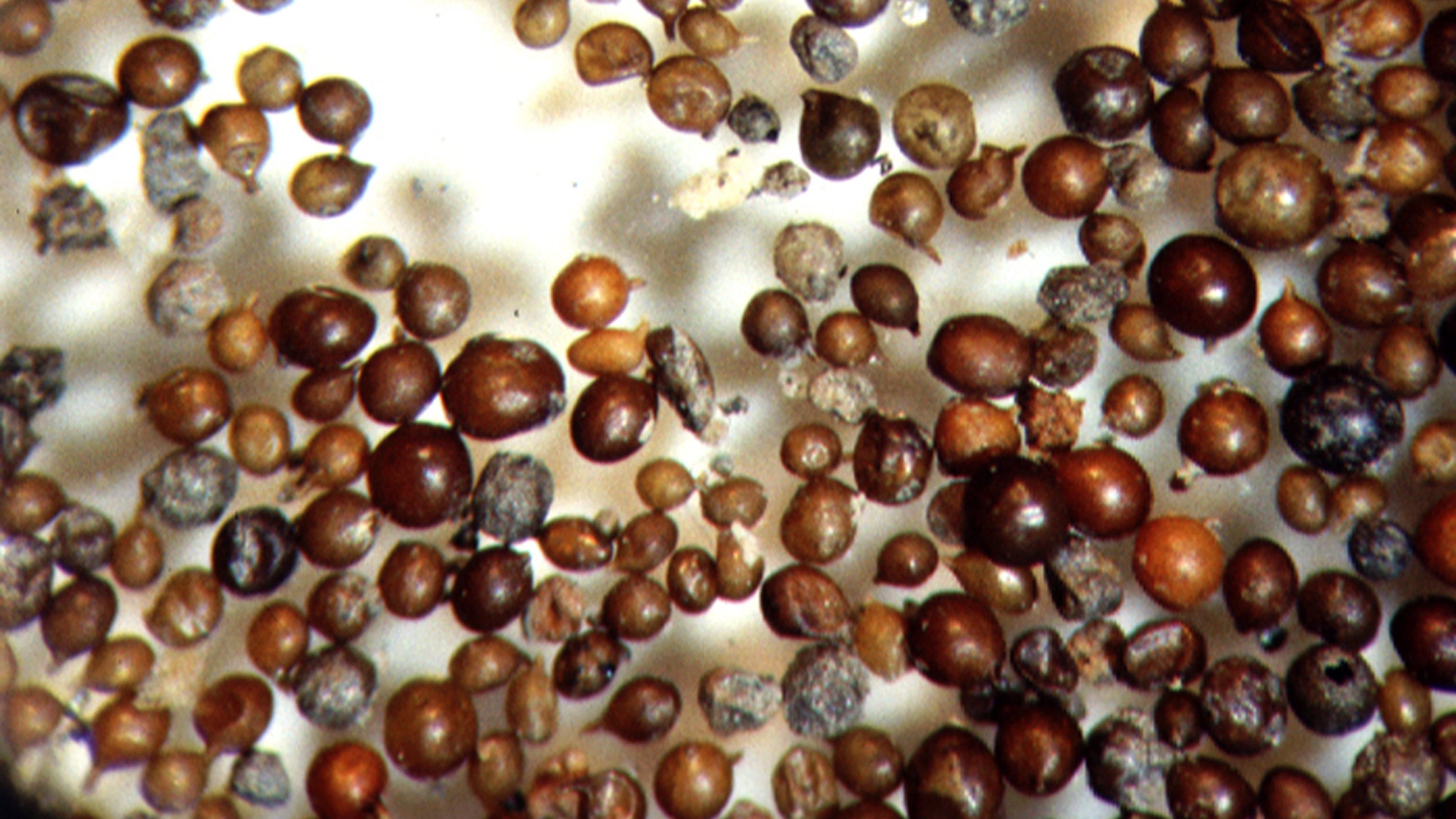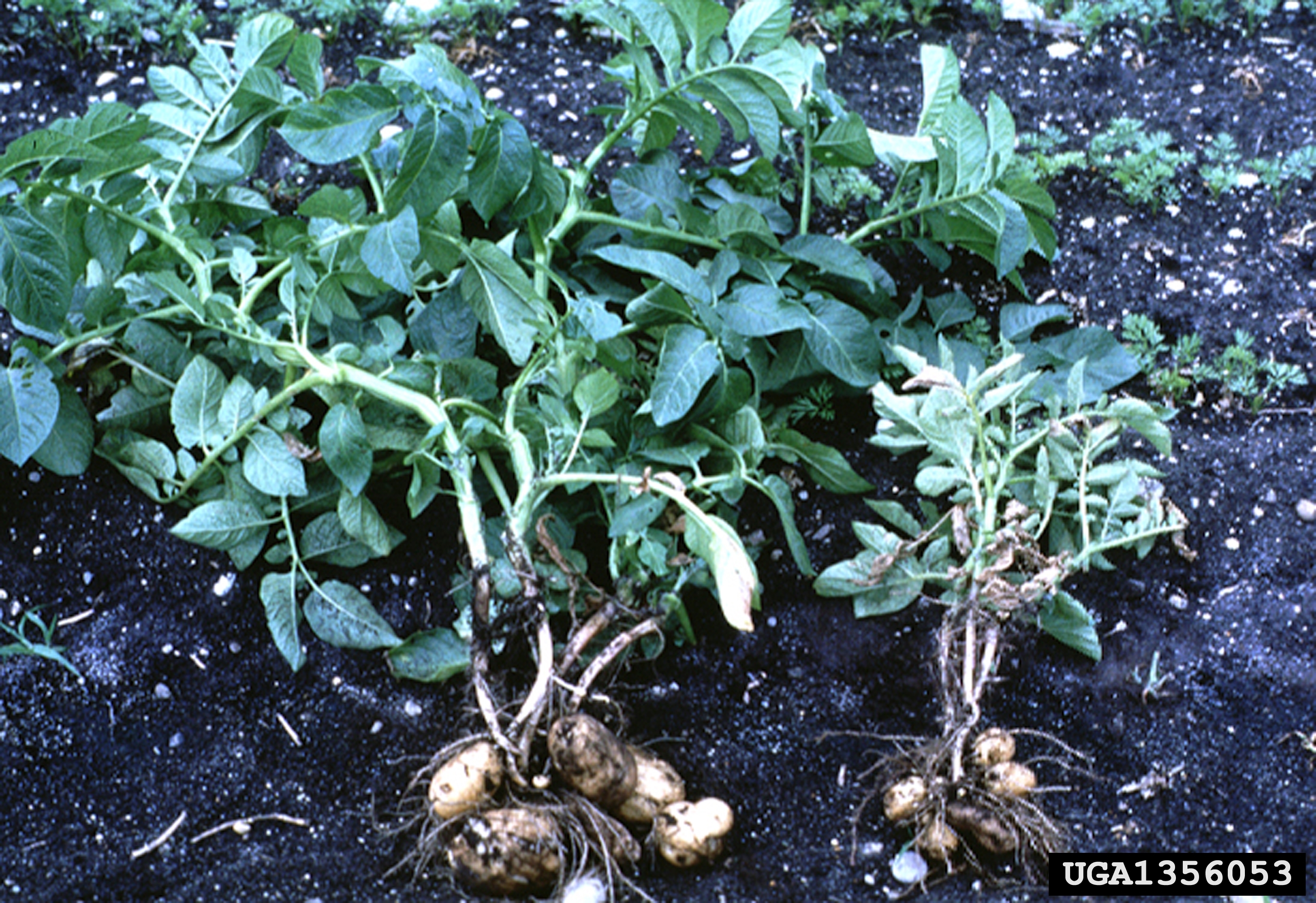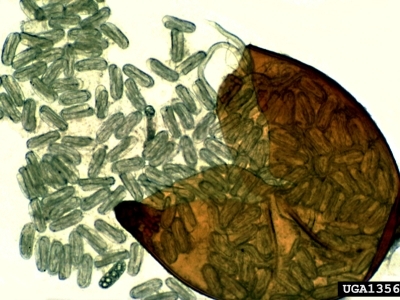Golden Nematode

Jonathan D. Eisenback, Virginia Polytechnic Institute and State University and Christopher Hogger, Swiss Federal Research Station for Agroecology and Agriculture respectively. Bugwood.org.
Golden nematode (Globodera rostochiensis; GN) is a soil-dwelling roundworm that feeds on the roots of potatoes. When a mated female dies, her body hardens and becomes a cyst that contains 300 to 500 viable eggs. These cysts can remain dormant and viable for 30 years.
The United States positively identified golden nematode in 1941 in the State of New York. The scientific community speculates that it was likely introduced when contaminated military vehicles returned from Europe. Golden nematode is native to the Andes Mountains of South America.
When golden nematode population levels are high, they can cause crop losses, increase pest control costs, and devalue infested land. When population levels are low, the pest may go undetected for years.
Here's what to look for in potato fields:
- Field symptoms
- Potato plants appear stunted with wilting and yellowed foliage. When nematode populations are high, potato fields appear patchy or clustered with plants showing poor growth.
- Cysts
- Microscopic round, spherical objects that appear to have a spout or protrusion. Cysts can be golden, orange, brown, or black in color. Several cysts will fit on a pinhead.
View the following images of golden nematode and the damage it causes.





Potato plants infected with Globodera rostochiensis. [Photo Source: Bonsak Hammeraas, NIBIO - The Norwegian Institute of Bioeconomy Research, Bugwood.org]
Potato plant on right infected with Globodera rostochiensis compared to healthy plant on left. [Photo Source:Christopher Hogger, Swiss Federal Research Station for Agroecology and Agriculture, Bugwood.org]
Painting of the life cycle of the golden nematode, Globodera rostochiensis. [Photo Source: A.D. Cushmon, Nemapix picture set, Bugwood.org]
A crushed cyst of Globodera rostochiensis with numerous eggs. [Photo Source: Ulrich Zunke, University of Hamburg, Bugwood.org]
Second-stage juveniles and eggs of Globodera rostochiensis. [Photo Source: Ulrich Zunke, University of Hamburg, Bugwood.org]
Growers should plant golden nematode-resistant potato varieties and strongly adhere to and participate in the golden nematode management program (for example, surveys and stringent cropping practices). Additionally, the following best practices will help to prevent the spread of golden nematode, pale cyst nematode, and other soil-borne organisms:
- Clean all farm machinery, trucks, construction and other equipment between fields. Do not allow equipment in your fields unless it has been thoroughly cleaned. This is especially important when renting land, as you may not have records of previous crop history.
- Check the condition of any trucks or other vehicles entering your farming operation. For example, a grower should check to see where vehicles have been previously and what sanitation treatments have been undertaken. Seed potato shipments are a particular concern for possible spread of golden nematode and pale cyst nematode where a truck may make more than one stop.
- Do not spread waste from potato grading, processing, or storage operations on farmland or place it in an area where it can be spread to farmlands.
- Leave hedgerows, sod barriers, or sod strips between fields and along highways.
- Prevent infestations by buying only certified seed that comes from fields that have been tested and found to be free of golden nematode and pale cyst nematode.
- Grow non-host crops (corn, small grain, and alfalfa) in rotations with potatoes and never plant pale cyst nematode-susceptible crops (potato, tomato, eggplant, pepper) back-to-back.
- Plant a potato cyst nematode-resistant variety, if available, in your non-infested fields at least once every 4 years.
- Plant cover crops as soon as possible when land is not in use because wind and water erosion can spread golden nematode and pale cyst nematode cysts.
- Inform people in your operation of the seriousness of golden nematode, pale cyst nematode, and potato diseases. Be sure they follow all precautions. Provide equipment needed to conduct proper cleaning and disinfection procedures.
- Segregate potatoes in storage—each field should have a definite separation.
- Do not re-use previously used bags or containers when transporting potatoes. Be sure all commercial transport vehicles are free of soil.
- Do not allow temporary help, custom applicators, or utility companies to bring their vehicles onto your farmland without proper sanitation. Do not allow them to bring into the field any bags or other items they might place on the ground because they could become contaminated.
- Do not use common headlands, farm roads, and public roads as turning areas.
- Prohibit non-authorized entry onto farmlands using “No Trespassing” signs.
- Do not assume that non-regulated fields are free of the pathogen.
Early detection and rapid response are key to controlling golden nematode. Pest management strategies include soil solarization, fumigation, crop rotation, and resistant cultivars.
- Solarization can be used if the infested area is small and newly affected.
- Fumigation is effective in reducing nematode populations while giving plants the opportunity to establish a good root system.
- Resistant cultivars with crop rotation is most effective. Golden nematode can be controlled by implementing an approved crop rotation schedule.
Report Plant Pests and Diseases
Have you seen this pest or signs of pest damage? Immediately report your findings.
Find your State plant regulatory official
Find your State plant health director
Controlling Golden Nematode
Golden nematode is a quarantine pest that has been confined to portions of eight counties in New York through a coordinated Federal, State, and Industry led pest management program.
Golden Nematode Quarantine Map (1.52 MB)
- Golden Nematode Domestic Quarantine Regulations
- Regulated Areas
- Map of Regulated Area
- Regulated Articles and Exempted Articles
- Federal Orders
- North American Plant Protection Organization Phytosanitary Alert System–View official pest reports from the United States, Canada, and Mexico.
- Potato Cyst Nematode Guidelines (695.71 KB) - Guidelines on Surveillance and Phytosanitary Actions (May 2014)
- Clarification to the Definition of "Field" (136.5 KB) (May 2015)
- Amendment to Facilitate Research and Field Trials (164.89 KB) (May 2019)
- Golden Nematode Program Manual (3.19 MB)
- Steam Treatment of Golden Nematode (54.97 KB)
- The Golden Nematode Handbook: Survey, Laboratory, Control, and Quarantine Procedures. Agriculture Handbook Year, 1968, Volume No. 353, U.S. Dept. Of Agriculture, Agricultural Research Service






